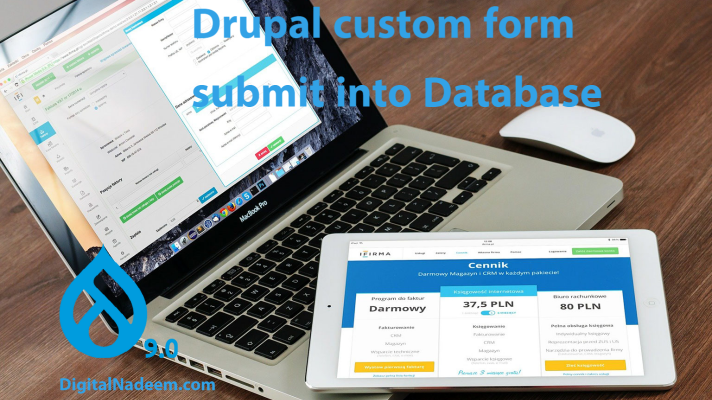How to create a custom form and submit data in to database in Drupal 8 and 9

In this article we are discussing about steps required to create a custom form. Here we are creating a custom form in our custom module with validations and submit data in to a custom table.
So after applying below changes you can a see a custom form as below which will save data in to the table students.

Assume dn_students is our custom module. Follow below 3 steps of implementation in this custom module.
Step1 – Create table schema in *.install file
Create a dn_students.install file in your module root folder path and place below code.
<?php
use Drupal\Core\Database\Database;
/**
* Implements hook_schema().
*/
function dn_students_schema(){
$schema['students'] = array(
'description' => 'The table for storing the students data.',
'fields' => array(
'id' => array(
'description' => 'The primary identifier for student',
'type' => 'serial',
'not null' => TRUE,
'unsigned' => TRUE,
),
'fname' => array(
'description' => 'Student name',
'type' => 'varchar',
'length' => 255,
'not null' => TRUE,
'default' => '',
),
'sname' => array(
'description' => 'Student second name.',
'type' => 'varchar',
'length' => 255,
'not null' => TRUE,
'default' => '',
),
'age' => array(
'description' => 'Age of student',
'type' => 'int',
'length' => 100,
'not null' => TRUE,
),
'marks' => array(
'description' => 'Mark of student',
'type' => 'int',
'length' => 100,
'not null' => TRUE,
),
),
'primary key' => array('id'),
);
return $schema;
}
During installation of dn_students module, students table will be created in your database with fields fname, lname , id, age and marks.
Step 2 – Create page path and form mapping in *.routing.yml
Add below code in dn_students.routing.yml
dn_students.add_student:
path: '/students/add'
defaults:
_title: 'Add Students'
_form: '\Drupal\dn_students\Form\StudentForm'
requirements:
_access: 'TRUE'
So, our form page URL is http://yourdomain/students/add
Next, we have to create form php file.
Step 3 – Create a form php file in path /src/Form
Create StudentForm.php file in module path /src/Form
This file has three functions ,
- BuildForm function for bulding form elements
- ValidateForm function for validating form values
- submitForm function for handing form data insertion to database.
See below full code in StudentForm.php.
<?php
namespace Drupal\dn_students\Form;
use Drupal\Core\Form\FormBase;
use Drupal\Core\Form\FormStateInterface;
use Drupal\Core\Database\Database;
use Drupal\Core\Url;
use Drupal\Core\Routing;
/**
* Provides the form for adding countries.
*/
class StudentForm extends FormBase {
/**
* {@inheritdoc}
*/
public function getFormId() {
return 'dn_student_form';
}
/**
* {@inheritdoc}
*/
public function buildForm(array $form, FormStateInterface $form_state) {
$form['fname'] = [
'#type' => 'textfield',
'#title' => $this->t('First Name'),
'#required' => TRUE,
'#maxlength' => 20,
'#default_value' => '',
];
$form['sname'] = [
'#type' => 'textfield',
'#title' => $this->t('Second Name'),
'#required' => TRUE,
'#maxlength' => 20,
'#default_value' => '',
];
$form['age'] = [
'#type' => 'textfield',
'#title' => $this->t('Age'),
'#required' => TRUE,
'#maxlength' => 20,
'#default_value' => '',
];
$form['marks'] = [
'#type' => 'textfield',
'#title' => $this->t('Marks'),
'#required' => TRUE,
'#maxlength' => 20,
'#default_value' => '',
];
$form['actions']['#type'] = 'actions';
$form['actions']['submit'] = [
'#type' => 'submit',
'#button_type' => 'primary',
'#default_value' => $this->t('Save') ,
];
//$form['#validate'][] = 'studentFormValidate';
return $form;
}
/**
* {@inheritdoc}
*/
public function validateForm(array & $form, FormStateInterface $form_state) {
$field = $form_state->getValues();
$fields["fname"] = $field['fname'];
if (!$form_state->getValue('fname') || empty($form_state->getValue('fname'))) {
$form_state->setErrorByName('fname', $this->t('Provide First Name'));
}
}
/**
* {@inheritdoc}
*/
public function submitForm(array & $form, FormStateInterface $form_state) {
try{
$conn = Database::getConnection();
$field = $form_state->getValues();
$fields["fname"] = $field['fname'];
$fields["sname"] = $field['sname'];
$fields["age"] = $field['age'];
$fields["marks"] = $field['marks'];
$conn->insert('students')
->fields($fields)->execute();
\Drupal::messenger()->addMessage($this->t('The Student data has been succesfully saved'));
} catch(Exception $ex){
\Drupal::logger('dn_students')->error($ex->getMessage());
}
}
}
Now install the file and access url /students/add.

You can see submitted details in students table as below.

Download sample module code here.


